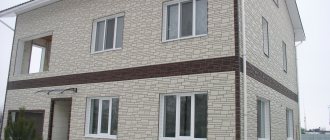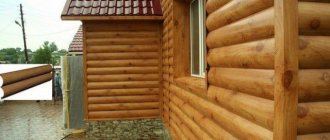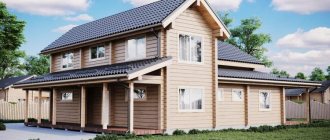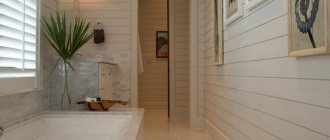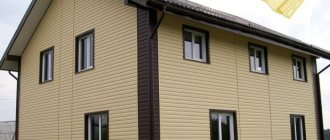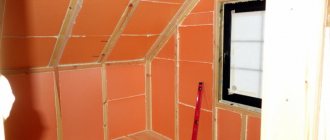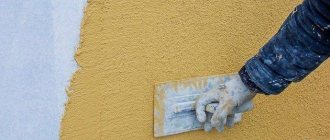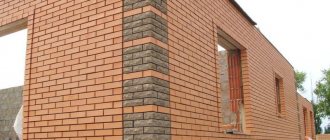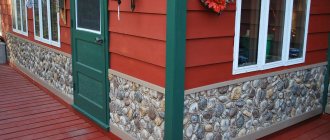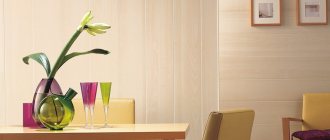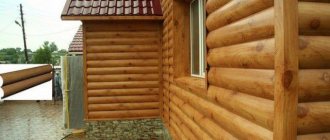The appearance of the house is an issue that is on the list of concerns, if not at the very beginning, then among the first.
For any owner, it is important what the facade looks like, what is the general impression created by the appearance of the building.
The material from which the walls are made often does not have outstanding decorative capabilities and requires the installation of an external covering, a layer of cladding.
In addition to aesthetic ones, there are also operational requirements, ensuring proper protection of walls from external influences.
This task is also in the scope of the functions of the cladding layer, increasing the responsibility of its service and increasing the requirements for its characteristics.
The choice of external cladding is a complex issue, since, along with the requirements for decorative and performance qualities, purely economic considerations come to the fore - the costs of material and work are no less important.
One of the most balanced materials in terms of price and properties is siding for cladding a house.
What is siding for the exterior of a house?
Siding is a material for exterior finishing of buildings and structures. Externally, it consists of long narrow panels that are interconnected into a set and allow you to create a cladding fabric of any area .
The panels have a longitudinal profile in the form of a specific element, in the set creating an imitation of a timber or log wall, stone or brickwork, ship planks, etc. The main feature of siding is ease of installation and the ability to do it yourself.
The material is easy to use and does not require highly qualified installers . At the same time, it requires serious preliminary preparation of the wall surface, since observation and any regulatory actions after installation of the cladding will become impossible.
The facade, finished with siding, has a stylish and neat appearance, defects in the geometry of the walls are corrected, and an elegant and collected appearance of the building is created. There is a wide selection of materials, colors and textures of panels that imitate both wooden elements and brick or stone masonry.
Photos of houses with beautiful siding:
Application of other types
The simplest siding is wooden, or, as it is also called, laminated lining. Panels of this type of cladding are made from wood fibers pressed under high temperature and high pressure. To ensure a high-quality and good connection, a special resin is used, which is added to the fibers of the material themselves.
Wood siding installation diagram.
To ensure good protection of the building and the siding itself, additional protective equipment is required. For example, wooden siding should be covered with several layers of paint and varnish. In this regard, this type loses its significance and gives way to more modern types of cladding. This is also due to the fact that wooden siding has a large number of disadvantages, among which are the following: short service life, good flammability, instability to moisture and the need to tint the material.
Cement is also used as a cladding material. The material contains both cement itself and cellulose fiber. At the last stage of manufacturing the panels, a certain texture is applied to the surface using a special method. This creates an imitation of wood.
This type has a number of advantages. The material is resistant to temperature changes, it feels great under the influence of wind, precipitation, and ultraviolet rays. Resistant to the formation of fungi and mold. Cement is completely unattractive to insects, which saves owners a lot of hassle.
In addition, the material has good color fastness, has a long service life and allows you to quickly give the building a beautiful look, decorate the building or eliminate possible unevenness in the walls. Installation of panels is not labor-intensive, maintenance of the building is quite simple and does not require knowledge of special skills
The material can also be used for cladding buildings, where fire safety requirements are given great attention, since cement is fire resistant
But at the same time, this type is not without its drawbacks. Among them are the high cost of such siding and the difficulty of cutting the material. During cutting, safety precautions must be observed, so it is necessary to use respirators to protect the respiratory tract from dust. In addition, this material is heavy, so a durable sheathing should be made for cement siding.
A new invention is the use of a material such as ceramics for cladding. This siding ranks in the middle in terms of material costs. For siding, ceramics is used, which includes clay, which contains some other natural materials.
Thus, ceramic panels are environmentally friendly, do not cause allergic reactions in humans and have good fire resistance.
Each type has good characteristics, but some of them are not without disadvantages
Therefore, it is important to decide whether it is worth purchasing beautiful wood siding if you can purchase durable metal siding
Advantages and disadvantages
Let's consider the advantages of the material:
- High decorative qualities.
- Wide choice of color, texture, type of simulated coating.
- Simplicity and speed of installation.
- Availability of all necessary components.
- High performance properties.
- In general, siding does not require any maintenance (with the exception of wood panels).
- Installation work can be carried out independently, without the involvement of specialists.
- Relatively low cost of material.
There are also some disadvantages:
- Installation work is carried out in several stages.
- Different types have their own characteristics that require thoughtful study to avoid errors during operation.
- Most types of material do not allow repair or replacement of a single panel without disassembling the entire panel.
NOTE!
It should be borne in mind that advantages or disadvantages are relative categories; with different attitudes, they can be very significant or completely invisible to the user. It all depends on the operating conditions and the owner’s attitude towards his property.
Vinyl
To be more precise, vinyl siding is actually made from polyvinyl chloride or PVC. This material has a large number of positive aspects:
- flexibility;
- resistance to burnout;
- crack resistance;
- light weight;
- ease of installation;
- high environmental friendliness;
- wide range of operating temperatures;
- not subject to corrosion.
PVC siding itself has good flexibility. This provides some freedom during installation work. This type of siding is available in a large number of colors. During the manufacturing process of the panels, which are later used to decorate the house, pigment dye is added, so it is easy to choose exactly what will best suit the overall exterior of the yard.
PVC siding perfectly withstands the effects of various acids, so in areas where there are large factories, its service life does not decrease. Siding sheets of this type can be fastened both vertically and horizontally.
Another undeniable advantage of this particular type of siding is its environmental friendliness. The manufacturing process does not use harmful solvents or other substances, so there are no harmful emissions even when heated. The operating temperature of such panels ranges from 50 degrees below zero to 50 degrees above zero. When installing PVC siding, it is necessary to cover the walls with insulation for external use. It is in this case that the desired effect will be achieved. One of the disadvantages of the material is its relative resistance to physical influences. It is also almost impossible to replace just one plank without dismantling the adjacent ones.
Specifications
Siding is made from different materials that have their own characteristics.
Therefore, we list the most general parameters common to all or most samples :
- Length - 2000-6000 mm (for basement - 950 mm).
- Width - 100-300 mm (basement - 450-630 mm).
- Thickness - 0.5-1.2 mm (wooden panels - 24-36 mm).
- The declared service life is 25-50 years.
- Frost resistance - from -50° to +60°.
There are more individual parameters that determine the more subtle qualities of the material, but they are different for each type and can only tell a specialist.
When purchasing material, you should carefully read the specified characteristics, and clarify any unclear points with the sellers . In this way, you can eliminate errors or discrepancies in order to purchase the most suitable material for yourself.
How to choose the most suitable panels?
Metal panels to imitate lining
Despite the supposed obviousness when choosing a material, assessing only the strengths and weaknesses may not yield results. A deeper analysis is needed here.
For example, vinyl panels have high elasticity, which means that they can easily withstand point impacts. The metal type resists such loads much worse, even though its strength is higher.
Sheathing a stone, frame or wooden house can be done with any type of this finishing coating. The main criterion for ensuring the implementation of all the properties of the material will be the proper fastening of the load-bearing frame to the wall of the building.
When choosing, you should also pay attention to the human factor - expensive aluminum siding should be installed only in well-protected areas.
When installing vinyl, plastic and steel panels, it is worth considering that depending on the temperature, the materials can expand and contract. Risks from such deformations are eliminated due to the loose fit of the screws to the frame posts. Also, oval cutouts are made at the trim attachment points.
Wooden panels imitating profiled timber
For finishing private buildings, vinyl siding imitating stone or brick is the most popular, since such material is quite easy to install and does not require further treatment with any impregnating compound.
Since the functional properties depend not only on the base material, but also on the method of additional processing and the presence of impurities, the final quality of the finishing coating depends on the manufacturer. As a rule, well-known brands use optimal ratios of impurities, which has a positive effect on the properties of materials.
If your choice falls on vinyl siding, you should pay attention to such manufacturers as Holzplast, CertainTeed, Novik, Mitten. Among Russian companies, Optima, Nord Haus and Grand Line produce quality products. High-quality cement siding is manufactured by the Russian company RosPan, the Japanese Nichiha and the Belgian Etemit.
The surfaces are fairly easy to clean with plain water.
Regardless of what type of siding is chosen, in cold regions it is recommended to additionally install a thermal insulation layer. If any damage occurs, it is recommended that it be repaired as quickly as possible, otherwise the sheathing may be subject to additional deformation, which could result in more expensive repairs if delayed.
You should not pay attention to too cheap materials from nameless manufacturers, otherwise caring for them may cost more.
Main types
There are the following types of siding:
- Vinyl.
- Wood.
- Metal.
These are the main types that are most widely used for cladding houses and have proven themselves in a certain way. There are other types that are less common for various reasons (mainly due to high cost), but for private houses the most preferable options are the listed types.
According to the direction of installation there are:
- Vertical siding.
- Horizontal siding.
By appointment it happens:
- Regular siding.
- Basement (lately it is increasingly called façade panels).
Both types can be used in any part of the façade; their names do not limit their use and, for the most part, serve only to indicate the type.
Vinyl
Vinyl siding is often referred to as any plastic panel. These, in addition to vinyl itself, also include acrylic and polypropylene panels, which have similar properties and appearance.
The material has a lot of positive qualities:
- Light weight.
- The elasticity of plastic allows you to compensate for mechanical stress (up to a certain limit).
- Large selection of panel colors.
- Highly realistic imitation of natural material. In addition to color, texture works, to create which a cast from natural wood, stone or brickwork, etc. is often used.
- Simple and easy installation.
- Low cost - of all types of siding, vinyl is the cheapest.
Disadvantages include a high coefficient of thermal expansion and some fragility at low temperatures. At the same time, temperature expansion is of concern only during installation, and changes in strength characteristics in winter can easily be avoided by refusing repair or installation work in cold weather .
Wood
Wood panels are among the most traditional types of cladding. It was with them that the formation and spread of siding as a cladding material began. Installation of wooden panels is very simple - tongue-and-groove.
The front side has a certain profile:
- Under a log.
- Under the beam.
- Ship board.
- Herringbone.
- L-beam.
All types of panels are equipped with several longitudinal grooves on the reverse side, designed to compensate for changes in size due to an increase or decrease in humidity.
The peculiarity of wooden panels is the need for periodic maintenance - painting, impregnation with drying oil or similar materials, varnishing . The need for this is due to the properties of wood as a material capable of swelling, warping and other consequences of contact with water or steam.
Manufacturers are developing and improving methods for stabilizing wood, making it minimally susceptible to moisture, but the problem has not yet been completely solved. Therefore, the canvas needs to apply a protective paint layer, which must be periodically refreshed and renewed.
The advantage of this situation is the opportunity to update the appearance of the house without changing the skin .
In addition, wooden panels allow minor repairs to be made without dismantling the entire panel, which cannot be done with panels made of other materials.
Wood siding includes WPC siding; you can read more about it here.
Metal
Metal siding is made mainly from galvanized steel with a multilayer polymer coating.
The panels have a profile similar to plastic or wooden samples:
- Beam.
- Log.
- Ship board.
- Herringbone, etc.
The main advantage of metal siding is the ability of the metal to deform without destruction. This allows the skin to withstand fairly strong mechanical impacts, but they leave marks on the surface - dents, dented or scratched areas.
If the integrity of the canvas remains unchanged, the appearance may be damaged, which requires replacement of the cladding elements. In addition, violation of the protective layer entails the start of the corrosion process and the appearance of rust spots, especially noticeable on light-colored panels .
At the same time, experts recommend preferring metal siding to any other type of material due to its strength, resistance to external influences, frost resistance and durability. Prices for metal panels are slightly higher than for vinyl, but lower than for wood siding.
This article compares metal and vinyl siding; we recommend reading it.
The installation procedure is almost the same as the technology for installing vinyl siding; all the necessary components are available .
Tsokolny
Basement siding was originally created to perform a narrow task - finishing parts of the foundation protruding from the ground. Hence the type of design of the panels - they imitate brick or stone masonry , and with a very high quality and degree of realism .
The size of the basement siding differs from the usual one - the panels are rectangular in shape, the sides are not straight, but follow the line of connection of the texture elements (joints of stone or brickwork). The set produces a continuous canvas, in which it is very difficult to find the joint line.
The high quality of material imitation, wide choice of colors or textures are appreciated by users. Currently, basement siding is successfully used for complete cladding of houses, and the result is much superior to conventional types of panels in all respects.
This circumstance was the reason for changing the name - now basement siding is increasingly called “facade panels”, which is much closer to reality.
There are metal and plastic facade panels. They have slightly changed parameters compared to conventional ones - the sheet is thicker; for the manufacture of plastic panels, not vinyl is used, but polypropylene as a more durable material.
The installation technology has also been changed, corresponding to the size and type of connection of the panels. The installation method is somewhat simpler due to the structurally elaborate side joining of the panels. The method of finishing openings, corners, and junctions has been simplified .
Plastic siding and its features
Plastic siding is unusually cheap and widespread.
But for all its popularity, it has very significant disadvantages:
Firstly, plastic siding resists mechanical stress very poorly: it bends, scratches and breaks quite easily. And even if you are not bothered by the deep scratches that appear on the surface of the plastic siding after just a couple of years of use, chips, dents, and breaks that form over time will not let you sleep peacefully. It is these defects that force premature renovation of the facade, investing time, effort and money in its appearance.
Secondly, plastic is very “afraid” of low temperatures; in severe frosts, its mechanical strength drops to critical values, which makes it impractical to use the material in harsh climatic conditions.
Thirdly, installing plastic siding does not contribute to fire safety at all.
Other types of siding
In addition to the types considered, there are more modern, but not yet widespread, types of siding. In particular, these include fiber cement panels , which have high performance parameters and strength . Ceramic siding is also highly durable.
The panels have an oblong shape, the surface is equipped with a relief that replicates the texture of wood or stone with a protective coating applied. The characteristics of the material are very successful, but distribution is largely hampered by the high price.
There are also PVC panels, you can read about them here.
In addition, there are samples of insulated panels (sandwich panels) . This material consists of technologically welded front metal panels with a backing layer of polyurethane foam insulation.
The material has its own installation technology, which requires an understanding of the physical processes occurring during heat-air exchange in rooms, otherwise you can “lock” water vapor inside the walls, thereby causing wetting or destruction of the house’s structures. When installed correctly, sandwich panels help retain heat and save on heating costs.
You can find out which siding is better in this article.
Types of siding cladding panels
Whenever it comes to types of siding for exterior decoration, most amateur builders only name metal and polymer panels. Although metal and plastic are not used more often than other materials in the production of siding panels for exterior decoration. It’s all about advertising and the history of the appearance of siding; the first types of external curtain cladding were metal and plastic stamped panels, so the private owner has a lot more information about them, they cost less, and it’s much easier to work with them.
In fact, in modern low-rise construction, the list of materials for siding panels for exterior decoration of a house is much wider; the most popular types of siding cladding are made from:
- Multilayer ceramics;
- Metal and polymer-metal stampings;
- Weather-resistant plastic;
- Cement-sand castings;
- Composite printed panels.
For your information! The list is far from complete, as new types of siding for exterior decoration are appearing, primarily based on natural, environmentally friendly and fireproof materials.
Main manufacturing companies
There are a lot of siding manufacturers in the world, which once again indicates the high demand for this material.
The most famous domestic brands include:
- Deke.
- Northside.
- Yu-plast.
- Fainbear.
- Grand Line.
- Alta-Profile.
- Dolomite.
- Block house.
From foreign:
- Kaycan.
- Vox.
- Novik.
- Cedral.
- Mitten.
- Georgia Pacific.
- Smart.
- Stone house.
- Tecos.
- Canadian.
- Nailite etc.
IMPORTANT!
The choice of the manufacturer of the material in a sense determines its quality, but in any case one should not be guided only by the brand; the technical characteristics and properties of the material should be studied.
Installation technology
Siding is installed on a sheathing (or subsystem) - a supporting structure that performs several functions in parallel :
- Supporting structure for panels.
- Leveling uneven walls.
- Support for insulation material.
You can read about installation components here.
Normal installation is done from the bottom up. A starting strip is installed, which is a separately made locking part of the panel. Corner or connecting H-profiles are immediately installed, window openings and a pediment are designed.
Then the installation of the panels begins. The lower part snaps into the lock of the starting bar or the previous panel, the upper part is fixed with self-tapping screws .
You can find out how and what to cover a house with here.
NOTE!
Tight fastening of panels to the sheathing is prohibited. The screw heads should be at a distance of 1.5-2 mm from the surface so that the panels can move sideways during thermal expansion of the material.
The installation of the finishing strip completes the installation..
You can read how to install it yourself here.
Sheathing care
- All types are easily washed with plain water. Light dirt can be easily removed using pressure from a garden hose;
- Heavy dirt can be removed using a soft brush. For wood flooring, it is recommended to use a soft cloth;
- despite the fact that many types are resistant to chemical influences, you should not specifically test them for strength - do not keep chemicals on the surface for more than five minutes;
- cleaning products are washed off with plain water;
- before purchasing metal panels, check whether it has an anti-corrosion layer or special impregnation - otherwise rust and corrosion may occur;
- a wooden facade must be updated every 2-3 years: the old paint is removed and then new paint is applied. If this option does not suit you, install siding that imitates the structure of wood - other materials just need to be cleaned of dirt.
We recommend reading: Modern materials for finishing the facades of private houses.
Comparison with other façade materials
Compared to other materials, siding has a significant advantage in ease and speed of installation. In addition, “wet” compounds are not used during work, which allows you to maintain cleanliness and operate in a landscaped area without damage .
Using siding greatly reduces the process of exterior finishing, simplifies work and significantly saves money. A wide choice of material type, color and texture of panels allows you to create a variety of cladding options, combine several colors or texture options.
The appearance of a house finished with siding changes significantly for the better; the building becomes neat and elegant.
In this article you will find out what is better - plaster or siding?
Types of materials
Siding is usually called structures made of PVC or steel, fixed to each other using special locking mechanisms. Plastic products in stores are presented in several versions:
- ordinary, unstable to mechanical stress;
- reinforced, made to look like stone;
- steel.
Steel panels have increased strength and are produced in the form of a formed sheet, which is suitable not only for external cladding, but also for interior finishing of non-residential premises. Although the price of metal siding is much higher, this is compensated by its long service life, but it is not practical to use it for interior decoration.
Plastic panels are characterized by increased moisture resistance and are not subject to fire, which has ensured their widespread use in the decoration of corridors, kitchens and bathrooms. They are easy to care for and are resistant to fading, dampness and detergents. The choice of design options in stores is not so wide, but every buyer has the opportunity to purchase custom-made siding. Although its production will take some time, but after waiting, the buyer will be able to get an original design.
MDF panels and lining do not tolerate dampness, so it is not advisable to use them for finishing basements, toilets and bathrooms. You can make wooden lining more resistant to moisture by treating it with special compounds, but it is worth remembering that this will be an additional cost, and you can always purchase material that is more suitable for a room with a similar regime.
When choosing options for wall cladding, you should take into account their features, cost and the amount of material that will be required to complete the finishing. In large construction stores, experienced consultants and designers will always come to the aid of customers and perform all calculations for free.
